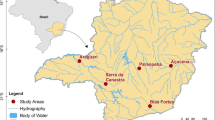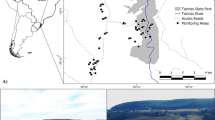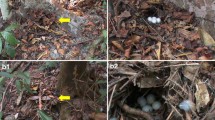Abstract
The study investigated the breeding season, nest site selection, clutch size, egg morphometry, and breeding performance of wild helmeted guineafowl (Numida m. meleagris) in the Arjo-Didessa River Valley Area, Western Ethiopia. Breeding data were collected during the 2018 and 2019 breeding periods. Its breeding ecology was studied by active nest monitoring techniques. Nest searches were carried out through intensive ground surveys using behavioral cues and systematically structured searching plots across the four habitat categories: grassland, farmland, forest, and riverine habitats. Egg morphometry measurement was examined using a portable vernier caliper (range: 0–150 mm, accuracy: 0.001 mm) and a digital balance (range: 2000 g × 0.1 g). Breeding performance was estimated as the percentage proportion of nests and eggs in a population sample that was successful in producing hatchlings. The active breeding season of helmeted guineafowl was from early June through late September when intensive egg-laying was observed. A total of 17 active nests comprising 207 eggs were located and monitored throughout the study period. Nests were located at a mean altitude of 1565.50 ± 270.50 m a.s.l. (range: 1295–1836). Most of the nests were observed in grassland (41.18%), followed by farmland (35.29%) and woodland forest (23.53%) habitats. No nest was recorded in the riverine areas. The species nest on the ground and prefer breeding areas scantily lined with essential vegetation cover. There was a statistically significant difference between habitat vegetation features and nesting site preferences of the species (P < 0.05). Helmeted guineafowl build nests with grass (45.39%), leaves (27.82%), feathers (11.46%), straw (8.95%), and other nesting constituents (6.38%) including dry weeds and lianas. Poaceae and Combretaceae were the most commonly used plants to construct nests. The mean clutch size of the species was 12.18 ± 4.40 (range: 5–19). The eggs were white creamy and sharp-shaped, with a mean egg shape index value of 60.36 ± 0.83 mm. The mean egg length, egg width, and egg weight of the species were 27.33 ± 0.19 mm, 16.44 ± 0.11 mm, and 43.42 ± 0.34 g, respectively. Its mean egg volume was 37.67 mm3. The breeding performance of helmeted guineafowl in the area was moderate with overall breeding (64.71%) and hatching (66.67%) successes. Its mean incubation period was 28.50 ± 1.83 (range: 25–32) days. The breeding performances of helmeted guineafowl varied between nesting habitats, by which the highest (100%) and lowest (50%) breeding success were recorded in the woodland forests and farmland areas, respectively. The breeding and hatching success of the species in the study area were highly influenced by human disturbance, abandonment, predation, and illegal egg collection activities. Further research and conservation efforts are, therefore, essential to understanding the post-fledging successes and maintaining the breeding and foraging areas which could enhance the breeding performance of the species and hence its conservation.


Similar content being viewed by others
Data availability
The field data sets and figures underlying the results of this study are presented in the research article.
Change history
08 June 2023
A Correction to this paper has been published: https://doi.org/10.1007/s43388-023-00134-4
References
Aire TA, Ayen JS, Olowo-Okorun MO (1979) The structure of the excurrent ducts of the testis of the guineafowl (Numida meleagris). J Anat 129:633–643
Ali MZ, Qureshi AS, Rehan S, Akbar SZ, Manzoor A (2015) Seasonal variations in histomorphology of testes and bursa, immune parameters and serum testosterone concentration in male guineafowl (Numida meleagris). Pak Vet J 35:88–92
Amat JA, Fraga RM, Arroyo GM (2001) Intraclutch egg-size variation and offspring survival in the kentish plover (Charadrius alexandrines). Ibis 143:17–23. https://doi.org/10.1111/j.1474-919X.2001.tb04165.x
Ash JS, Atkins JD (2009) Birds of Ethiopia and Eritrea an atlas of distribution. Christopher Helm, London
Ayeni JSO (1980) The biology and utilization of helmeted guineafowl (Numida meleagris galeata Pallas) in Nigeria. Ph.D. Thesis, University of Ibadan, Ibadan
Belshaw RH (1985) Guinea fowl of the world. Minirod Book Services, Hampshire, England., World of Ornithology
Biddle LE, Broughton RE, Goodman AM, Deeming DC (2018) The composition of bird nests is a species specific characteristic. Avian Biol Res 11:132–153. https://doi.org/10.3184/175815618X15222318755467
BirdLife International (2022) Numida meleagris. The IUCN Red List of Threatened Species 2018:e.T22679555A132052202. https://doi.org/10.2305/IUCN.UK.20182.RLTS.T22679555A132052202.en Accessed 15 July 2022
Briggs KB, Biddle LE, Deeming DC (2019) Geographical location affects size and materials used in the construction of pied flycatcher (Ficedulahypoleuca) nests. Avian Res 10:1–15. 10.0.4.162/s40657019-0156-7
Burger J (1985) Habitat selection in temperate marsh nesting birds. In: Cody M (ed) Nest-site selection in birds. Academic Press, New York, pp 253–281
Cancellieri S, Murphy MT (2014) Experimental analysis of nest-site choice and its relationship to nest success in an open-cup–nesting passerine. Auk 131:539–548. https://doi.org/10.1642/AUK-13-251.1
Castilla AM, Van Dongen S, Herrel A, Francesch A, Martínez de Aragón J, Malone J, Negro JJ (2010) Increase in membrane thickness during development compensates for eggshell thinning due to calcium uptake by the embryo in falcons. Naturwissenschaften 97:143–151. https://doi.org/10.1007/s00114-009-0620-z
Chimdessa K, Quraishi S, Kebede A, Alamirew T (2018) Effect of land use land cover and climate change on river flow and soil loss in Didessa River Basin, South West Blue Nile, Ethiopia. Hydrology 6:1–20. https://doi.org/10.3390/hydrology6010002
Christians JK (2002) Avian egg size: variation within species and inflexibility within individuals. Biol Rev Camb Philos Soc 77:1–26. https://doi.org/10.1017/S1464793101005784
Church KE, Taylor JS (1992) Management and research of northern bobwhite Colinus virginianus in North America: an overview. Gibier Faune Sauvage 9:787–796
Cody ML (1985) Habitat selection in birds Academic Press London
Collias NE, Collias EC (1984) Nest building and bird behaviour. Princeton University Press
Crowe TM (1978) Limitation of the population in the helmeted guineafowl. S Afr J Wildl Res 8:117–126
Crowe TM, Siegfried WR (1978) It’s raining guineafowl in the northern Cape. S Afri J Sci 74:261–262
Deeming DC (2016) How does the bird-nest incubation unit work? Avian Biol Res 9:103–113. https://doi.org/10.3184/175815516X14567543242701
Dyke GJ, Kaiser GW (2010) Cracking a developmental constraint: egg size and bird evolution. Rec Aust Mus 62:207–216. https://doi.org/10.3853/j.0067-1975.62.2010.1547
Embury I (2001) Raising guinea fowl. Agfact A5.0.8. New South Wales Agriculture Publications, New South Wales, Australia
Evans KL (2003) The potential for interactions between predation and habitat change to cause population declines of farmland birds. Ibis 146:1–13. https://doi.org/10.1111/j.1474-919X.2004.00231.x
Fu Y, Chen B, Dowell SD, Zhang Z (2016) Nest predators, nest-site selection and nest success of the emei shan liocichla (Liocichla omeiensis), a vulnerable babbler endemic to southwestern China. Avian Res 7:1–6. https://doi.org/10.1186/s40657-016-0054-1
Halupka L, Czyż B, Macias Dominguez CM (2020) The effect of climate change on laying dates, clutch size and productivity of Eurasian coots Fulica atra. Int J Biometeorol 64:1857–1863. https://doi.org/10.1007/s00484-020-01972-3
Hansell MH, Deeming C (2002) Location, structure and function of incubation sites. In: Deeming DC (ed) Avian –incubation: behaviour, environment and evolution. Oxford University Press, pp 8–27
Hansell MH (2000) Bird nests and construction behaviour. Cambridge University Press, UK
Hedberg I, Edwards S (1989) Flora of Ethiopia and Eritrea. Pittosporaceae to Araliaceae. 3, The National Herbarium, Addis Ababa, Ethiopia, and Department of Systematic Botany, Uppsala, Sweden
Hedberg I, Edwards S, Nemomissa S (2003) Flora of Ethiopia and Eritrea. Apiaceae to Dipsacaceae.Vol. 4,.The National Herbarium, Biology Department, Science Faculty, Addis Ababa University, Ethiopia
Hoyt DF (1979) Practical methods of estimating volume and fresh weight of bird eggs. Auk 96:73–77. https://doi.org/10.1093/auk/96.1.73
Jamieson IG, Ryan CJ (2000) Increased egg infertility associated with translocating inbred takahe (Porphyrio hochstetteri) to island refuges in New Zealand. Biol Conserv 94:107–114. https://doi.org/10.1016/S0006-3207(99)00158-5
Johnson D (1979) Estimating nest success: the Mayfield method and an alternative. Auk 96:651–661. https://doi.org/10.1093/AUK/96.4.651
Karakaya M, Arikan K (2015) The nest-site characteristics of the forest population of common blackbird (Turdus merula) in Ekisehir, Turkey. Turk J Zool 39:295–299. https://doi.org/10.3906/zoo-140136
King’ori AM (2012) Poultry eggs external characteristics. Egg weight, shape and shell color. Poultry Sci 5:14–17. https://doi.org/10.3923/rjpscience.2012.14.17
Klett AT, Duebbert HF, Faanes CA, Higgins KF (1986) Techniques for studying nest success of ducks in upland habitats in the prairie pothole region. U.S. Fish and Wildlife Service
Klomp H (1970) The determination of clutch size in birds: a review. Ardea 58:1–124. https://doi.org/10.5253/arde.v58.p1
Koenig WD (1982) Ecological and social factors affecting hatchability of eggs. Auk 99:526–536. https://doi.org/10.1093/auk/99.3.526
Kragten S, Nagel JC, De Snoo GR (2008) The effectiveness of volunteer nest protection on the nest success of northern lapwings Vanellus vanellus on Dutch arable farms. Ibis 150:667–673. https://doi.org/10.1111/J.1474-919X.2008.00842.x
Martin TE, Scott J, Menge C (2000) Nest predation increases with parental activity: separating nest site and parental activity effects. Proc R Soc B-Biol Sci 267:2287–2293. https://doi.org/10.1089/rspb.2000.1281
Martin K (1995) Patterns and mechanisms for age-dependent reproduction and survival in birds. Am Zool 35:340–348. https://doi.org/10.1093/icb/35.4.340
Martin TE, Geupel GR (2016) Nest-monitoring plots: methods for locating nests and monitoring success. J Field Ornithol 64:507–519
Mentis MT, Poggenpoel B, Maguire RRK (1975) Food of the helmeted guineafowl in highland Natal. S Afri J Wildl Res 5:23–25
Narushin VG, Romanov MN (2007) Egg physical characteristics and hatchability. World Poultry Sci J 58:297–303. https://doi.org/10.1079/WPS20020023
Njiforti HL (1997) The breeding performance of wild helmeted guineafowl (Numida meleagris galeata Pallas) in the Waza National Park, North Cameroon. Rev Ecol 52:173–186
Nol E, Blanken MS, Flynn L (1997) Sources of variation in clutch size, egg size and clutch completion dates of semipalmated plovers in Churchill, Manitoba. Condor 99:389–396. https://doi.org/10.2307/1369945
Pinowska B, Barkowska M, Pinowski J, Bartha A, Hahm KH, Lebedeva N (2004) The effect of egg size on growth and survival of the tree sparrow Passer montanus nestlings. Acta Ornithol 39:121–135. https://doi.org/10.3161/0001645044213910
Ratcliffe CS, Crowe TM (2001) Habitat utilisation and home range size of helmeted guineafowl (Numida meleagris) in the midlands of KwaZulu-Natal province, South Africa. Biolo Conserv 98:333–345. https://doi.org/10.1016/S0006-3207(00)00176-2
Redman R, Stevenson T, Fanshawe J (2009) Birds of the horn of Africa: helm field guides. Christopher Helm Press, London
Rita T, Ja’nos TL, Hegyi G (2005) Effects of environmental conditions and parental quality on inter- and intra clutch egg-size variation in the collared flycatcher (Ficedulaalbicollis). Auk 122:509–522. https://doi.org/10.1093/auk/122.2.509
Skutch AF (1985) Clutch size, nesting success, and predation on nests of tropical birds, reviewed. Ornithol Monogr 36:575–594. https://doi.org/10.2307/40168306
Soler JJ, Møller AP, Soler M (1998) Nest building, sexual selection and parental investment. Evol Ecol 12:427–441
Streby HM, Refsnider JM, Andersen DE (2014) Redefining reproductive success in songbirds: moving beyond the nest success paradigm. Auk 131:718–726. https://doi.org/10.1642/AUK-14-69.1
Summers JD, Leeson S (1983) Factors influencing early egg size. Poultry Sci 62:1155–1159. https://doi.org/10.3382/ps.0621155
Tomás G, Merino S, Puente JM, Moreno J, Morales J, Aguilar JR (2013) Nest size and aromatic plants in the nest as sexually selected female traits in blue tits. Behav Ecol 24:926–934. https://doi.org/10.1093/beheco/art015
Thompson FR (2007) Factors affecting nest predation on forest songbirds in North America. Ibis 149:98–109. https://doi.org/10.1111/j.1474-919X.2007.00697.x
Winkler DW, Walters JR (1983) The determination of clutch size in precocial birds. Curr Ornithol 1:33–68. https://doi.org/10.1007/978-1-4615-6781-32
Winter M, Hawks SE, Shaffer JA, Johnson DH (2003) Guidelines for finding nests of Passerine birds in tallgrass prairie. USGS Northern Prairie Wildlife Research Center. 160. https://digitalcommons.unl.edu/usgsnpwrc/160. Accessed 14 April 2023
Zeleke G, Urge M, Animut G, Esatu W, Dessie T (2020) Comparative laying performance, egg quality, fertility and hatchability of guineafowl with Tilili, Horro and Potchefstroom Koekoek chicken breeds. Open J Anim Sci 10:665–682. https://doi.org/10.4236/ojas.2020.104043
Zhao J, Yang C, Lou YQ, Shi M, Fang Y, Sun Y (2020) Nesting season, nest age and disturbance, but not habitat characteristics, affect nest survival of Chinese grouse. Curr Zool 66:29–37. https://doi.org/10.1093/CZ/ZOZ024
Acknowledgements
We thank Wachemo University, Addis Ababa University, The Department of Zoological Sciences Thematic Research Project (AAU), and The Idea Wild Organization for their financial support and invaluable contributions.
Author information
Authors and Affiliations
Corresponding author
Ethics declarations
Conflict of interest
The authors declare no competing interests.
Rights and permissions
Springer Nature or its licensor (e.g. a society or other partner) holds exclusive rights to this article under a publishing agreement with the author(s) or other rightsholder(s); author self-archiving of the accepted manuscript version of this article is solely governed by the terms of such publishing agreement and applicable law.
About this article
Cite this article
Aynalem, Y., Bekele, A. & Bogale, B.A. Breeding biology of the helmeted guineafowl (Numida meleagris meleagris, Linnaeus 1758) in Western Ethiopia. Ornithol. Res. 31, 173–181 (2023). https://doi.org/10.1007/s43388-023-00132-6
Received:
Revised:
Accepted:
Published:
Issue Date:
DOI: https://doi.org/10.1007/s43388-023-00132-6




